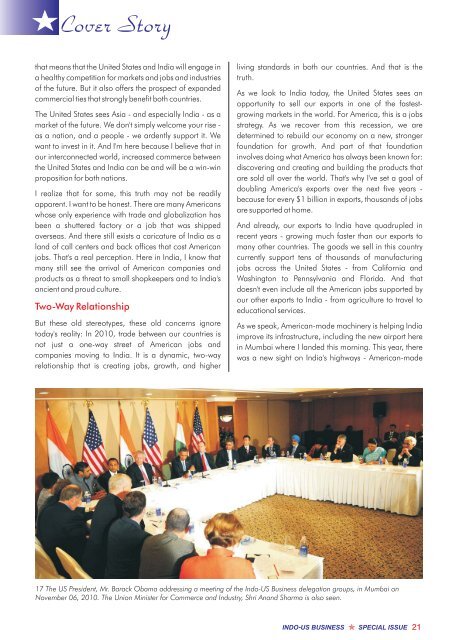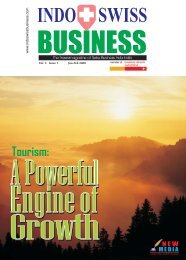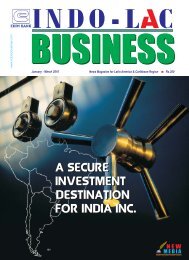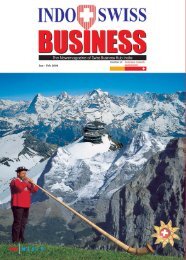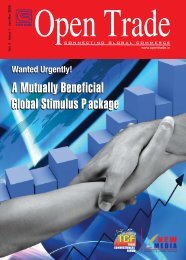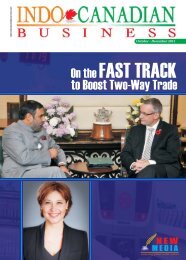Full page fax print - Indo-American Chamber Of Commerce
Full page fax print - Indo-American Chamber Of Commerce
Full page fax print - Indo-American Chamber Of Commerce
Create successful ePaper yourself
Turn your PDF publications into a flip-book with our unique Google optimized e-Paper software.
Cover Story<br />
that means that the United States and India will engage in<br />
a healthy competition for markets and jobs and industries<br />
of the future. But it also offers the prospect of expanded<br />
commercial ties that strongly benefit both countries.<br />
The United States sees Asia - and especially India - as a<br />
market of the future. We don't simply welcome your rise -<br />
as a nation, and a people - we ardently support it. We<br />
want to invest in it. And I'm here because I believe that in<br />
our interconnected world, increased commerce between<br />
the United States and India can be and will be a win-win<br />
proposition for both nations.<br />
I realize that for some, this truth may not be readily<br />
apparent. I want to be honest. There are many <strong>American</strong>s<br />
whose only experience with trade and globalization has<br />
been a shuttered factory or a job that was shipped<br />
overseas. And there still exists a caricature of India as a<br />
land of call centers and back offices that cost <strong>American</strong><br />
jobs. That's a real perception. Here in India, I know that<br />
many still see the arrival of <strong>American</strong> companies and<br />
products as a threat to small shopkeepers and to India's<br />
ancient and proud culture.<br />
Two-Way Relationship<br />
But these old stereotypes, these old concerns ignore<br />
today's reality: In 2010, trade between our countries is<br />
not just a one-way street of <strong>American</strong> jobs and<br />
companies moving to India. It is a dynamic, two-way<br />
relationship that is creating jobs, growth, and higher<br />
living standards in both our countries. And that is the<br />
truth.<br />
As we look to India today, the United States sees an<br />
opportunity to sell our exports in one of the fastestgrowing<br />
markets in the world. For America, this is a jobs<br />
strategy. As we recover from this recession, we are<br />
determined to rebuild our economy on a new, stronger<br />
foundation for growth. And part of that foundation<br />
involves doing what America has always been known for:<br />
discovering and creating and building the products that<br />
are sold all over the world. That's why I've set a goal of<br />
doubling America's exports over the next five years -<br />
because for every $1 billion in exports, thousands of jobs<br />
are supported at home.<br />
And already, our exports to India have quadrupled in<br />
recent years - growing much faster than our exports to<br />
many other countries. The goods we sell in this country<br />
currently support tens of thousands of manufacturing<br />
jobs across the United States - from California and<br />
Washington to Pennsylvania and Florida. And that<br />
doesn't even include all the <strong>American</strong> jobs supported by<br />
our other exports to India - from agriculture to travel to<br />
educational services.<br />
As we speak, <strong>American</strong>-made machinery is helping India<br />
improve its infrastructure, including the new airport here<br />
in Mumbai where I landed this morning. This year, there<br />
was a new sight on India's highways - <strong>American</strong>-made<br />
17 The US President, Mr. Barack Obama addressing a meeting of the <strong>Indo</strong>-US Business delegation groups, in Mumbai on<br />
November 06, 2010. The Union Minister for <strong>Commerce</strong> and Industry, Shri Anand Sharma is also seen.<br />
INDO-US BUSINESS SPECIAL ISSUE<br />
21


